Wartime Heritage
ASSOCIATION

copyright © Wartime Heritage Association
Website hosting courtesy of Register.com - a web.com company
In Defence of Freedom - Northern Italy
The Story of Halifax II BB412

In Defence of Freedom - Northern Italy
The Story of Halifax II BB412
148 RAF Squadron (Special Duty Operations)
The valley between Mount Cavallaria and Mount Gregorio in northern Italy was shrouded in darkness and heavy fog on the
night of September 11, 1944. Partisans of the Don Minzioni detachment of the 76th Garibaldi" Brigade were on guard in the locality
of Lettola, on the slopes of Mount Cavallaria. They heard the aircraft still distant and invisible enter the valley corridor from the
south.
There seemed to be a change of course to the left, a sudden increase in engine speed, a tremendous roar, as the aircraft
progressively regained altitude from the center of the valley upwards in what must have been an attempt to overcome the
mountain peak. On its invisible trajectory, it passed over a farmhouse a few meters from the roof, at full throttle with sparks of
flame spurting from an engine.
And then, an enormous explosion, and a growing glow that illuminated the top of the mountain. The night was then marred by
fire and continuous explosions that lasted until dawn.
Partisans arriving at the site saw scattered wreckage, destroyed, or damaged weapons, parachutes splashed out of
containment bags, ammunition for portable weapons, and significant quantities of paper money.
The air smelled of fuel, paint, and charred bodies. Clearly, there could be no survivors and despite the persistent widespread
presence of the fire, they began a search.
The forward part of the aircraft and the wing airframe had disintegrated. One half of the aircraft fuselage, from the center to
the tail assembly, appeared intact but burned. The RAF circular identification painted on the aircraft, was un-marred.
Twelve bodies, all victims of the horrific crash and fire were laid out for burial and one more body, the rear tail gunner,
untouched by the fire. A villager at the crash site recalled the “handsome blond boy who seemed to be sleeping …”
The bodies, buried by the partisans, were placed in a mass grave near the crash site. Two tubular containers from the aircraft
and a cross were erected to mark the grave.
The flight book, contained in a protective case, survived the crash, and made it possible to determine there had been
thirteen men aboard the aircraft.
On Monday, September 11, 1944, Halifax II BB412/C of 148 RAF Squadron (Special Duty Operations) departed RAF Brindisi at
7:30 pm on an SOE (Special Operations Executive) Operation.
The aircraft was manned by a crew of eight and carried five passengers. Three were personnel of No.1 Special Force (SOE), A
British Captain of the Parachute Regiment Army Air Corps and two Czechoslovakians, a Staff Captain, and a Corporal (Radio
Operator), and two Sergeant paratroopers, personnel of the Italian Army.
The code name used by the Squadron for the operation was “Silica II North, Seed and Acre”. The operation objective was to
drop supplies to partisans in the Champorcher area, north-western Italy, in the Aosta Valley region north of Ivrea, and to deploy the
SOE operatives.
The first part of the SOE operation was Silica I South. It had landed in Mettolo Castellino in the Maritime Alps at 20 km south-
east of Cuneo on September 9, 1944, to make contact with the 3rd Partisan Division "Alps". The “Silica II” Operation was to
establish contact with the Czechoslovakian soldiers, drafted into the Wehrmacht forces to fight in Italy, and persuade them to
defect. A first attempt was made on September 9th but returned to RAF Brindisi when bad weather was encountered. A second
attempt to complete the “Silica II” operation was made on September 11th and departed RAF Brindisi in the early evening.
Halifax II BB412/C of 148 RAF Squadron (Special Duty Operations) failed to return from the operation and the aircraft and
those onboard were presumed to have been lost.
It was not until information was received from partisans of the Garibaldi Brigade, an Italian partisan group, which relayed the
information in July 1945 - that on September 12, 1944, a partisan patrol reported that on the night of September 11th, a Halifax
aircraft had crashed in the area of Mount Cavallaria. In December of 1945 the RCAF Overseas Headquarters reported that the
wreckage of an unidentified aircraft had been found in that mountainous area approximately twenty-five miles north of Turin in
north-western Italy. This was the district over which Halifax II BB412/C of 148 RAF Squadron was detailed to fly on the night of
September 11th and the early morning of September 12, 1944. The number of bodies, reported found with the aircraft, coincided
with the number of personnel carried aboard the plane but no identification of the aircraft or personnel had yet been made. The
Graves Registration Unit was further investigating to locate the graves and if possible, to make positive identification.
In October 1946, the Graves Registration Unit in Northern Italy confirmed the location of the missing plane and the
missing personnel of Halifax II BB412. The bodies of the thirteen were removed from the graves where they were
buried by the partisan group, and were re-interred in collective graves in the Milan War Cemetery, Italy.
THE CREW
Pilot Officer John Ervin O’Brien (J/87441), Royal Canadian Air Force, (Pilot) Age 21.
Born in Regina, Saskatchewan on January 5, 1923 he was the only son of Vincent
O’Brien and Velma Elizabeth O’Brien. He enlisted in the RCAF on April 24, 1942, at the
age of 19, in Regina. He was 5 feet, 8 inches in height, of medium complexion, blue eyes,
and brown hair and was a student at Campion College, Regina, the time of his enlistment.
He went overseas arriving in the United Kingdom on July 1, 1943 and on July 7, 1944 he
joined 142 RAF Squadron.
“Although your son John had not been with us any length of time, during his stay on
the Squadron he had made himself very popular with his fellow air crew, and was
extremely well liked by the ground crew working on the machines he flew. As an officer
he was both keen and efficient and always willing to undertake duties and
responsibilities exceeding the normal line of duty …” (D. G. Hayword, Wing Commander,
148 Squadron)
Pilot Officer John Ervin O'Brien is Commemorated on Page 407
of the Second World War Book of Remembrance
Canadian Virtual War Memorial
Flight Sergeant Douglas Julius Starling Ives (1615762), Royal Air Force Volunteer Reserve,
(Flight Engineer) Age 21
Douglas Julius Ives was the son Sidney Arthur of Ellen Leonora (Starling) Ives of
Einterton-road, Hemsby, Norfork. Born in 1923, he enlisted with the Royal Air Force
Volunteer Reserve and served with 148 Squadron.
Commemorated on the Hemsby War Memorial
Flight Sergeant Bruce Woodward Ellison (4310166), Royal New Zealand Air Force,
(Navigator) Age 26
Bruce Woodward Ellison was the on of Percy Charles Ellison and Gwenllian
Glamorgan (Richards) of Napier, Hawke's Bay, New Zealand. Born on May 24, 1918 he
enlisted in the Royal New Zealand Navy on December 18, 1940 and embarked for England
in December 1940. He transferred to the Royal Air Force on December 18, 1941 and was
transferred to Canada for BCATP training in August, 1942. On September 28, 1942, Bruce
Woodward Ellison was transferred to No. 5 Air Observers School, Winnipeg, Manitoba
where he graduated and was awarded his Air Observer’s Badge on January 22, 1943. He
returned to the United Kingdom in February 1943 for ongoing training.
Flight Sergeant Ellison was transferred to the Royal New Zealand Air Force on
November 1,1943, and proceeded to No.1652 Conversion Unit at Marston Moor,
Yorkshire. In March 1944, he was assigned to the Bomber Development Unit at
Newmarket. From there he was posted in April to the Ferry Unit Pershire,
Worcestershire. He proceeded to Maison Blanche in Algiers by way of St Mawgan in
Cornwall. Flight Sergeant Ellison finally landed at Rabat in Africa. On June 15, 1944, he travelled to
Foggia to join No. 148 RAF Squadron at Brindisi.
Warrant Officer Richard Alvinzie Crowell, (R/153348), Royal Canadian Air Force, (Wireless
Operator/Air Gunner) Age 21
Born in Shelburne, Nova Scotia, Richard Alvinze Crowell was the only son of Robert
and Eva Mary (Cunningham) Crowell. He officially enlisted with the RCAF at Halifax, NS,
on May 28, 1942. Richard completed training at Lachine, Quebec, between June 15, 1943
and September 11, 1942; No. 1 Bombing and Gunnery School at Jarvis, Ontario, between
September 12, 1942 and October 23; and at Wireless School at Guelph, Ontario, between
October 24, 1942 and May 16, 1943.
He continued training at RCAF Mossbank, Saskatchewan between May 17, 1943 and
June 28, 1943. He qualified as Wireless Operator on May 17, 1943 and obtained his Air
Gunner’s Badge on June 28, 1943. He embarked at Halifax on July 7, 1943 and
disembarked in the United Kingdom on July 29, 1943. There, he was taken on strength
with the RAF Training Pool. On March 24, 1944 he departed the UK for North Africa where
he served with 614 RAF Squadron before being taken on strength with 142 RAF Squadron
between July 7, 1944 and August 15, 1944. Flight Sergeant Crowell was joined 148 RAF
Squadron (Special Duty Operations) on August 15, 1944 at RAF Brindisi, Italy.
Warrant Officer Richard Alvinze Crowell is Commemorated on Page 283
of the Second World War Book of Remembrance
Canadian Virtual War Memorial
Flying Officer Joseph Miller Parkinson, (J/27460), Royal Canadian Air Force, (Air Bomber)
Age 25
Born in Belfast, Ireland, Joseph Miller Parkinson was the son of William and Morah
Parkinson and husband of Eileen Victoria Sprint of Winnipeg, Manitoba. At enlistment he
was living in Galt, Ontario. Prior to enlistment he was a clerk at the Royal Bank of Canada
in Sault Ste. Marie, Ontario between 1936 and 1938, and a bookkeeper with District
Services Ltd., also in Sault Ste. Marie, between 1938 and 1941. Single at the time of
enlistment, he married on June 26, 1943. They had one child Eileen Elizabeth Parkinson
(b. March 15, 1944).
He enlisted at the age of 22 with the Royal Canadian Air Force on July 14, 1941, in
Galt, Ontario. He went overseas embarking Canada on July 16, 1943 and disembarking in
the United Kingdom on July 23, 1943. He was posted to 148 RAF Squadron on July 7,
1944.
Flying Officer Joseph Miller Parkinson is Commemorated on Page 411
of the Second World War Book of Remembrance
Canadian Virtual War Memorial
Flight Sergeant James Howard Ireland (R/162102), Royal Canadian Air Force, (Air
Gunner) Age 20
James Howard Ireland was the son of William Howard Ireland (d. and Jessie
Alberta Ireland, of MacGregor, Manitoba.
Born on February 3, 1924, he enlisted with the Royal Canadian Air Force on April
7, 1942 at Winnipeg, Manitoba at the age of 18. He embarked for overseas on March 9,
1943 and disembarked in the United Kingdom on March 17, 1943. He received his Air
Gunner Badge on June 14, 1943. He joined 148 RAF Squadron on August 15, 1944.
Flight Sergeant James Howard Ireland is Commemorated on Page 342
of the Second World War Book of Remembrance
Canadian Virtual War Memorial
Sergeant Ronald McKeen (2210512), Royal Air Force Volunteer Reserve, (Air Gunner)
Age 19
Born in 1924, Ronald McKeen was the son of Thomas James McKeen and Elsie
(Keeble) McKeen of Liverpool, England. He enlisted with the Royal Air Force (Volunteer
Reserve), trained as an Air Gunner, and was stationed at RAF Brindisi, Italy with the 148
RAF Squadron in 1944.
Flight Sergeant Albert Major Vanderhart (R/206366), Royal Canadian Air Force,
(Air Gunner) Age 23
Albert Major Vanderhart, born April 24, 1821, was the only son of Peter
Vanderhart and Lauretta (Major) Vanderhart of Toronto, Ontario.
Albert Vanderhart enlisted with the Royal Canadian Air Force on November 20,
1942, at Toronto, Ontario. Following training in Canada he went overseas, disembarking
in the United Kingdom on October 16, 1943. He joined 148 RAF Squadron at RAF
Station Brindisi, Italy on July 27, 1944.
Flight Sergeant Albert Major Vanderhart is Commemorated on Page 467
of the Second World War Book of Remembrance
Canadian Virtual War Memorial
SOE PERSONNEL
Captain Charles F. Whitaker (199620) Parachute Regiment, Army Air Corps (Age 23)
Charles Frederick Whitaker was born on March 26, 1921, in Holland to Squadron
Leader J Whitaker. He spoke five languages and travelled and lived in many parts of
Europe. In 1941, he was commissioned into the Special Operations Executive (SOE) and
worked with the Dutch Section.
In early 1942, he transferred to the 1st Parachute Brigade, and attended parachute
training course number 12 at RAF Ringway, between 20 March and 1 May.
Lieutenant Whitaker was Intelligence Officer for the 3rd Parachute Battalion and
for the 1st Parachute Brigade. Lieutenant Whitaker saw service with the Parachute
Regiment in North Africa, Sicily, and Italy, and in 1943, he became Platoon Commander in
the 3rd Para Bn. He was later attached to the 1st Foreign Legion.
In October 1943, Captain Whitaker was posted back to SOE, and was sent to North
Africa, Italy and Yugoslavia. On September 11, 1944, Captain Whitaker was flying to Val
Grande on an operation.
Staff Captain Rudolf Hrubec (J.1172), Czech Army (Age 29)
Rudolf Hrubec was born November 15, 1914, in Bernartice, Czech Republic, the son
of František and Cecílie (Lukešová) Hribec.
He first entered the military in 1934, was trained as a cavalry officer and held the
rank of Lieutenant when he left the army in 1936 to attend a Technical University in
Prague where he studied aircraft design. He returned to active duty until he was
demobilized on May 19, 1939, after the occupation of Bohemia and Moravia.
On June 8, 1939, together with Rudolf Krzák, he left the Czech Republic for Poland
and from Krakow was sent to France. On August 10, 1939, he joined the Foreign Legion
and was sent to Tunisia. After the outbreak of war, he was assigned to the Czechoslovak
Foreign Army and assigned to the 2nd Infantry Regiment. On July 7, 1940, he was
evacuated to England.
In England, he was assigned to the command company of the 2nd Infantry Regiment
and was trained for special tasks. From May 4 to October 28, 1941, he completed two
parachutes and a sabotage courses. He was appointed commander of the STS 2 - Bellasis, at Dorking, Surrey, a SOE (Special
Operations Executive) training school used by Czech Section for training and holding. He was a liaison officer with British
intelligence services involved in parachutist training and also acted as an air dispatcher on flights to the Protectorate.
In 1942, he completed a special course with Polish paratroopers and a conspiracy course. At the end of 1942, he was
appointed commander of the Czechoslovak section at waiting station at STS 46 in Buckinghamshire. From May 3, 1943 he served as
Commander of the 8 Stanhope Terrace station, London, a SOE billet for personnel. From July 12th, he served as Commander of STS
1, at Brock Hall, Flore, Northamptonshire.
On October 8, 1943, he flew to Italy, where he became Commander of Czechoslovak dispatch centers and Deputy, Special D.
On August 11, 1944, he left for Bari as a member of the Silica Operations Group.
Corporal Bohuslav Nocar (R.196) Czech Army (Age 23)
Bohuslav Nocar was born on October 22, 1920, in Pilsen, the Czech Republic.
He graduated from business school in Pilsen and Zlín, and worked as a shoe saleman. In
March 1938, he was sent as an intern to England and from there to New York. In
September 1939, the company sent him to Trinidad as the head of the Bata store
network. At the end of the contract, he joined the Czechoslovak Foreign Army and went
to England via New York in March 1941.
After training, he was assigned to a Telegraph Company, and after completing a
parachute course, he was first, the Commander of the radio station at Battalion
Headquarters, and later a training instructor and weapons officer. In October 1942, he
was promoted to the rank of Private. Trained for special tasks, he completed a radio
course from August 26 to August 28, 1944. He was assigned to Operation Silica as a Radio
Operator.
Sergeant Rudolfo Marchiori, Paratrooper Department, Royal Italian Army (Age 20)
Rudolfo Marchiori was born in Rovigo, in north-east Italy. He was a student of the
Livorno Academy, and on the Vespucci training ship in the Adriatic when the Armistice
(surrender of the Italians to the Allies) was signed on September 3, 1943. The crew
landed in Brindisi, already occupied by the Allies. There, the reconstituted Italian Royal
Army joined with Allied troops.
Sergeant Marchiori, paratrooper, lent himself to difficult missions of being parachuted into German-occupied Italian territory,
to keep in touch with the partisans in the northern mountain ranges of Italy.
Sergeant Gudio Alessandro Voglino, Paratrooper Department, Royal Italian Army (Age 20)
Gudio Alessandro Voglino was born in Milan. When the Armistice (surrender of the
Italians to the Allies) was signed on September 3, 1943, he joined the reconstituted Royal
Italian Army as a paratrooper.
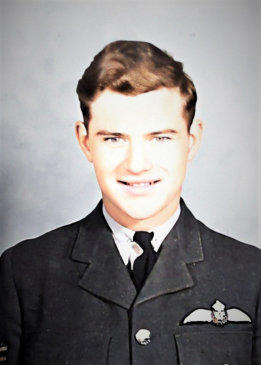
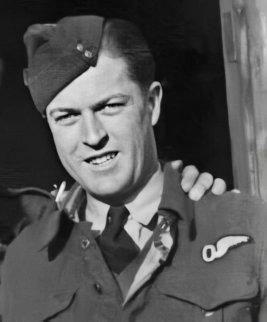
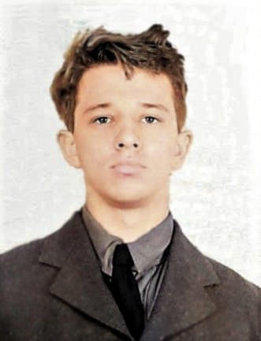
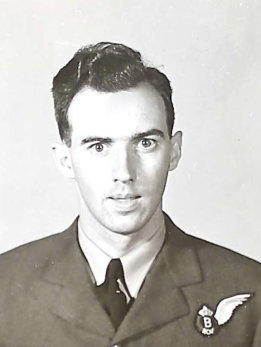
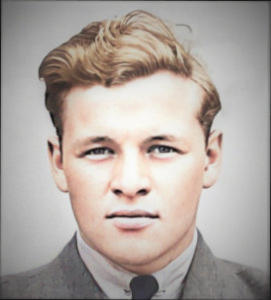

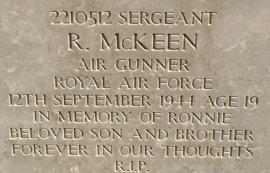
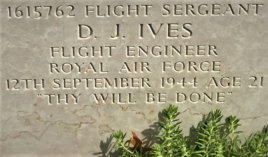
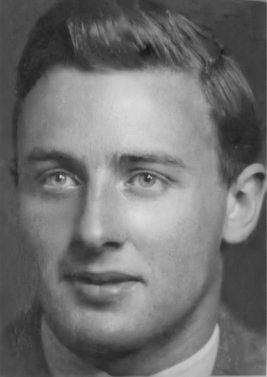
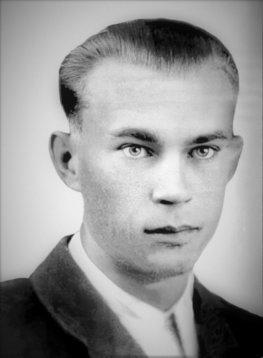
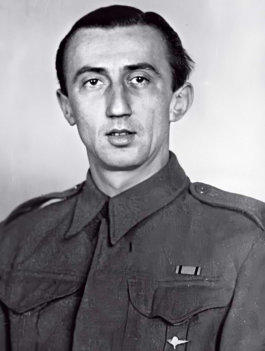
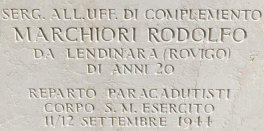
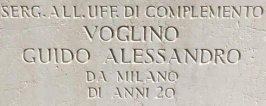



Milan War Cemetery
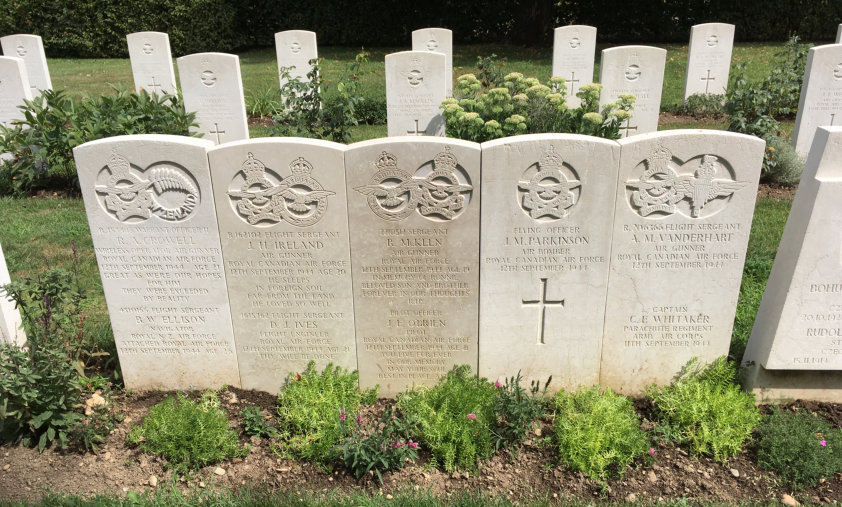
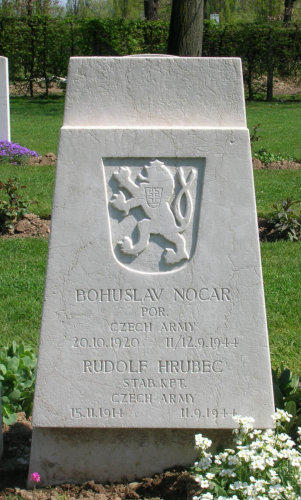
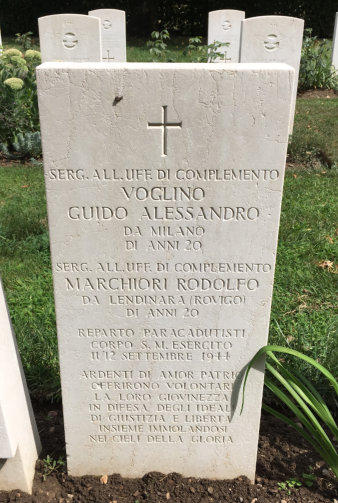
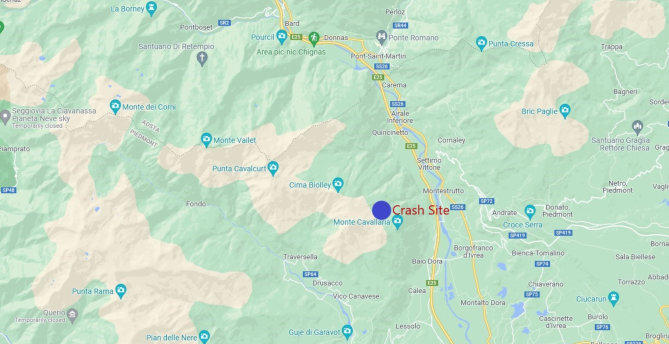
MOUNT CAVALLARIA
In 2014, a Monument was placed next to the chapel in honour of the Madonna della Cavallaria at about one thousand and
600 meters on Mount Calvallaria. The aircraft wing flap was donated by the Aviators Association of Ivrea.
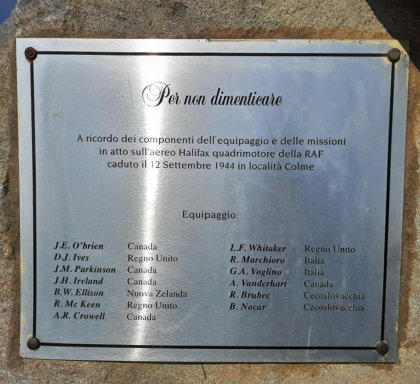
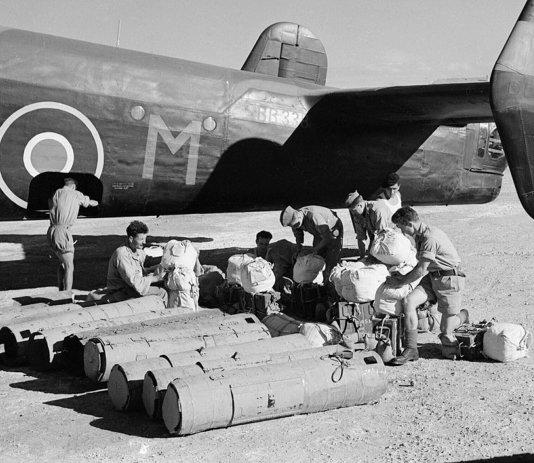
148 RAF Squadron
CLE Canisters about to be loaded onto a Handley Page Halifax
bomber of 148 Squadron, which will drop them on Yugoslav
Partisans. Brindisi, Italy, c. 1944
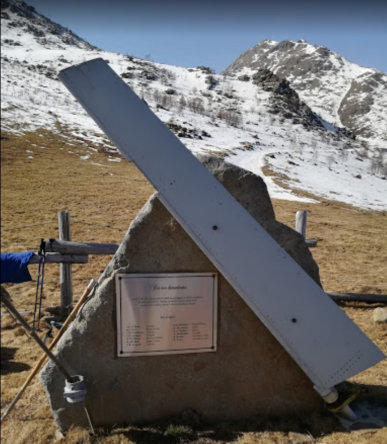
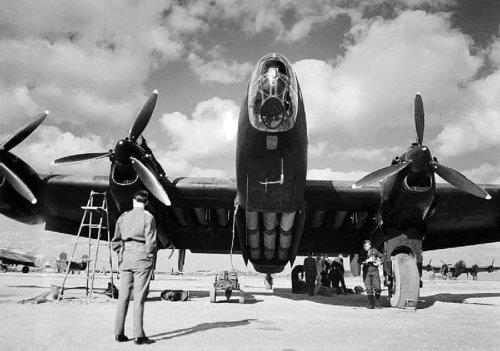
Loading of containers with weapons and operational material
for Italian guerrillas
Acknowledgements:
The information and photos for the article are from many sources, including the Commonwealth War Graves Commission, the
Canadian Virtual War Memorial, findagrave, and the military service records of the crew. Additional information from Wikiloc
(biancpier); La Voce: “Brosso. In ricordo dei morti della Cavallaria (In memory of the dead of Cavallaria)” Andrea Bucci; Chi
era Costui - Rodolfo Marchiori; Military aviation disasters in the north-western Alps (1910 - 1960) author, Fabrizio Dassano;
Historical information related to 148 RAF Squadron; Auckland Museum - war-memorial/online-cenotaph; and Thesis /
Dissertation: Career of Rudolf Krzák and Rudolf Hrubec by Michal Nauš.
© IWM CNA 3231




- World War I - Menu
- WWI Stories and Articles
- Photos - Yarmouth Soldiers
- Selection of World War I Songs
- WWI Casualties of Yarmouth, NS
- Those Who Served - Yarmouth, NS
- WWI Casualties Digby Co. NS
- WWI Casualties Shelburne Co. NS
- Merchant Mariners (1915) Yarmouth, NS
- Canadian Forestry Corps - Non Yarmouth Birth/Residence Enlistments
- US Draft Registry - Yarmouth NS Born


- World War II - Menu
- WWII Stories and Articles
- Telegraphist Air Gunners
- WWII Casualties of Nova Scotia
- US Casualties with NS Connection
- Far East/Pacific Casualties with NS Connection
- Merchant Navy Casualties Nova Scotia
- Nova Scotia WWII Casualties Holten Canadian War Cemetery
- D-Day Casualties - Nova Scotia
- CANLOAN Program Casualties - Nova Scotia
- Battle of the Bulge Casualties - Nova Scotia
- WWII Casualties Yarmouth NS
- Yarmouth Casualties - RCAF RAF Canadian Army WWII
- Yarmouth Co., Marrages WWII
- Casualties Non-Born/Residents with Connection to Yarmouth Co., Nova Scotia.
- WWII Casualties Digby Co., NS
- Non-Nova Scotian WWII Casualties Buried in Nova Scotia
- WWII RCAF Casualties Aged 16-18
- Brothers/Sisters Who Served - World War II













